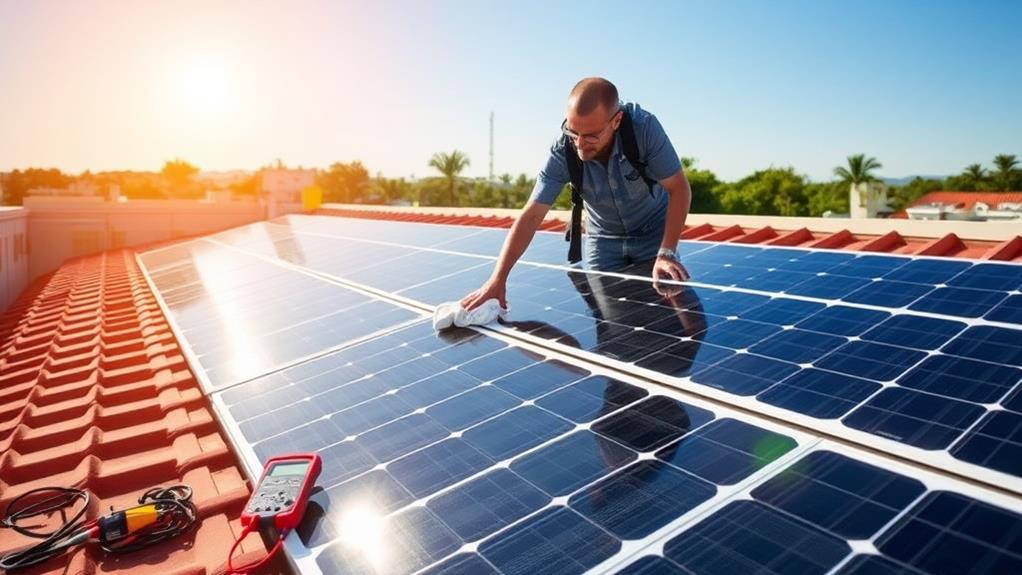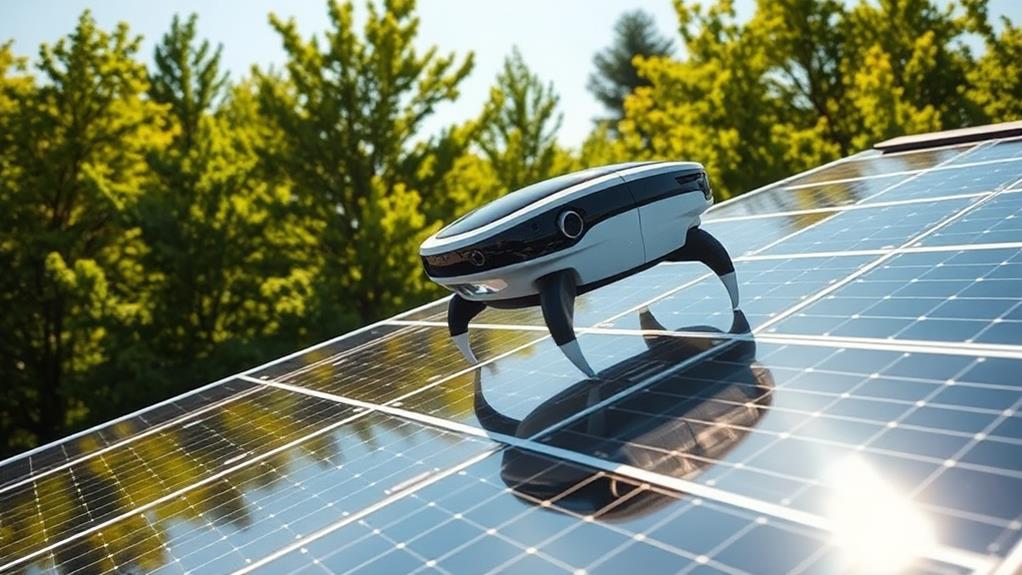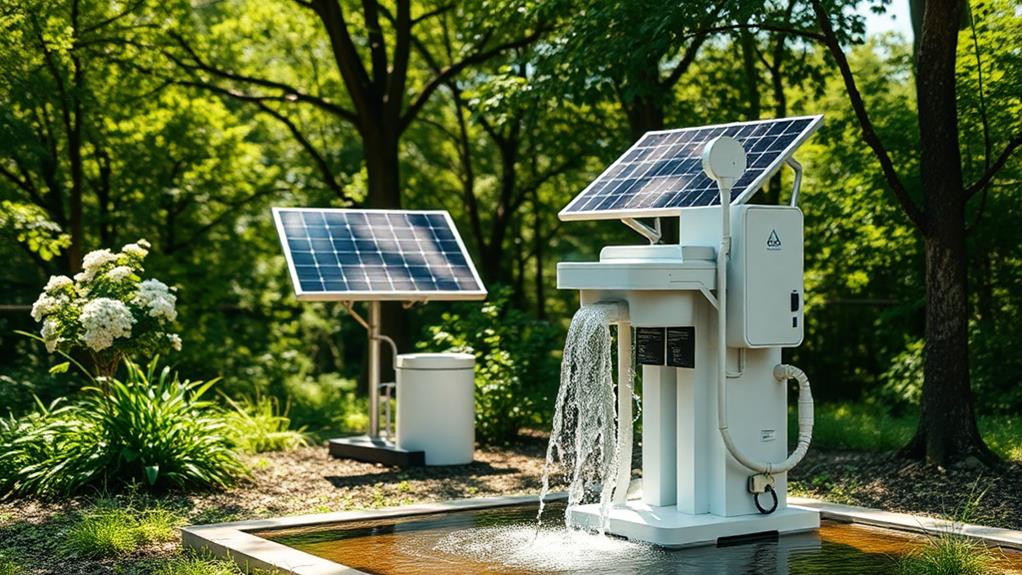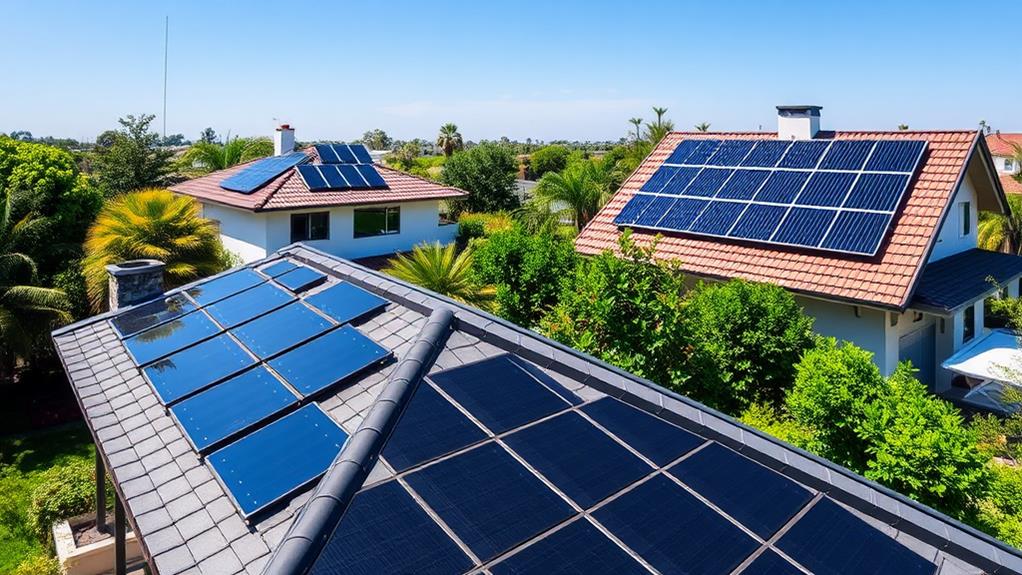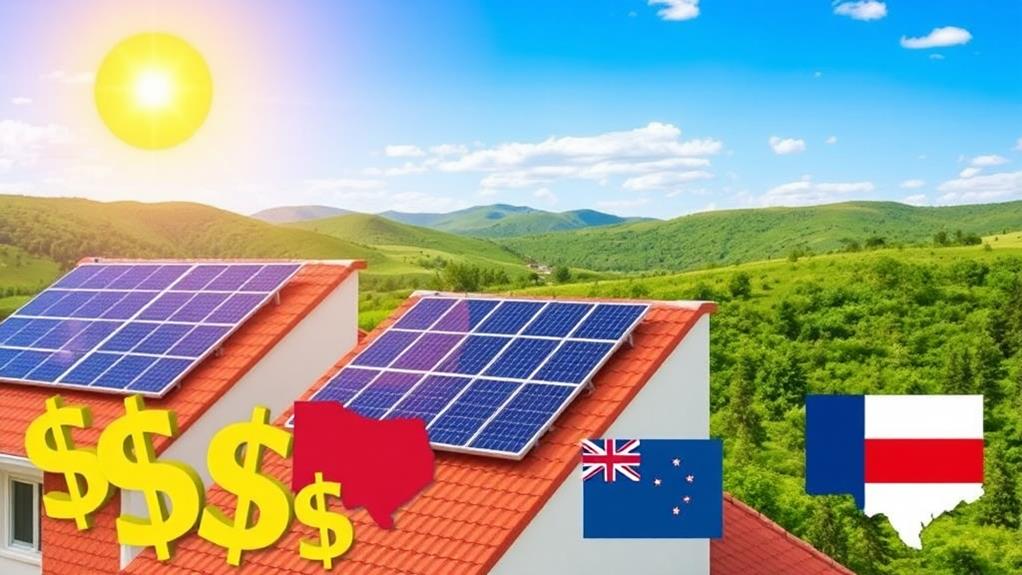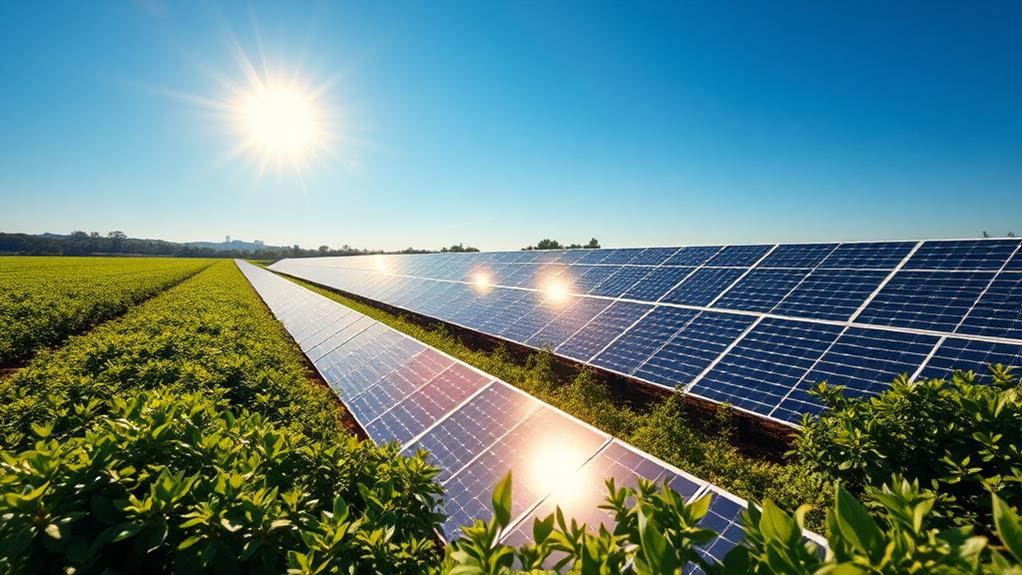When we assess the seven best solar energy financing options, we identify cash purchases, solar loans, leasing, and alternative solutions, each with distinct advantages. Cash purchases require upfront costs between $13,986 and $27,972, while solar loans range from $1,000 to $100,000 at interest rates of 6% to 36%. Leasing provides lower initial costs but sacrifices tax credit eligibility. Additionally, we explore home equity financing, property-assessed clean energy (PACE) loans, and local rebates, all designed to facilitate solar adoption. By comparing these financing avenues, we can strategically align our financial needs with solar energy benefits—further insights await.
Key Takeaways
- Cash Purchases: Require substantial upfront costs between $13,986 and $27,972 but provide full ownership and tax credit eligibility.
- Solar Loans: Offer flexible repayment terms and amounts from $1,000 to $100,000, with interest rates ranging from 3.99% to 36%.
- Leasing Options: Lower initial costs are appealing, but leasing forfeits ownership and federal solar tax credits.
- Home Equity Financing: Utilizes home equity for lower interest rates, typically between 3.99% and 35.99%, with terms from 5 to 30 years.
- Federal and State Incentives: Include a 30% federal tax credit and potential local rebates, significantly reducing overall installation costs.
Overview of Solar Financing Options
When it comes to financing solar energy systems, we've got several options to contemplate, each tailored to different financial situations and goals. The primary solar financing options include cash purchases, solar loans, and leasing solar panels. Cash purchases maximize ownership benefits and energy savings, though upfront costs can range from approximately $13,986 to $27,972. Alternatively, solar loans, ranging from $1,000 to $100,000, allow flexibility with interest rates between 6% and 36%, yet they still facilitate energy savings. Home equity financing and unsecured personal loans remain popular choices for obtaining solar loans, with APRs typically varying from 3.99% to 35.99%. Keep in mind that leasing solar panels offers lower initial costs but forfeits eligibility for the federal solar tax credit and ownership.
Types of Solar Loans

Exploring the various types of solar loans can help us find the best fit for financing our solar energy systems. By understanding these options, we can make informed decisions aligned with our financial goals. Here are some common types of solar loans:
- Unsecured Personal Loans: Flexible terms from 2 to 7 years, but higher interest rates ranging from 6% to 36%, based on our credit scores.
- Home Equity Financing: Utilizes home equity as collateral, often offering lower rates and terms from 5 to 30 years.
- Cash-Out Refinancing: Allows refinancing of an existing mortgage to access cash for solar panel installation with potentially lower interest rates.
Each option has unique repayment terms and interest rates, so it's crucial to evaluate which best suits our needs.
Comparing Top Solar Lenders
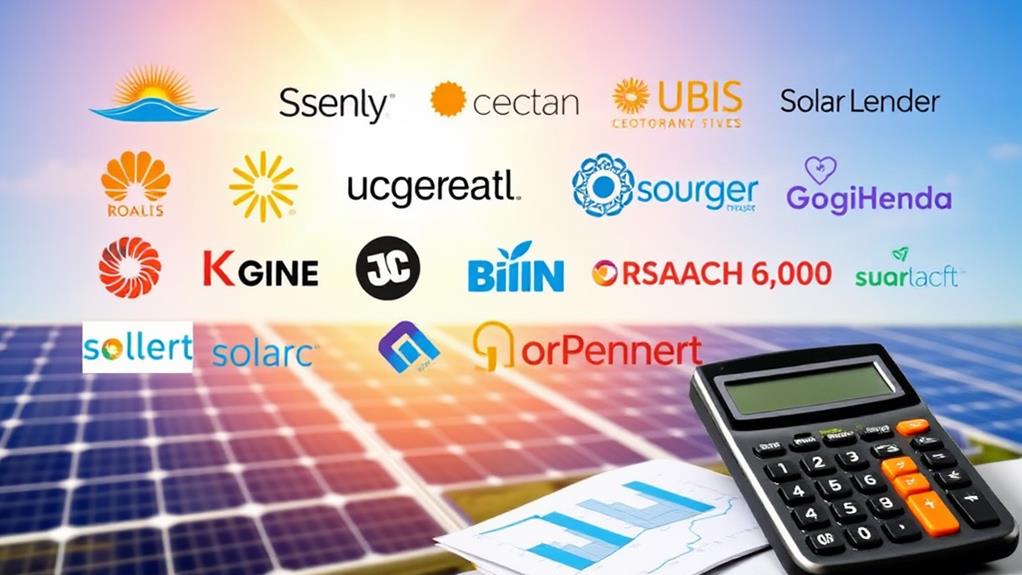
With so many options available, comparing top solar lenders is essential to find the best financing solution for our solar energy projects. Each lender offers unique features, loan amounts, and credit score requirements, impacting our decisions for financing solar panels.
| Lender | Loan Amounts | APR Range | Minimum Credit Score Requirement |
|---|---|---|---|
| SoFi | $5,000 – $100,000 | 8.99% – 29.99% | None |
| LightStream | $5,000 – $100,000 | 6.99% – 25.29% | 660 |
| LendingPoint | $1,000 – $36,500 | 7.99% – 35.99% | 600 |
| Upgrade | $1,000 – $50,000 | 9.99% – 35.99% | 580 |
| Discover | $2,500 – $40,000 | 7.99% – 24.99% | 660 |
Understanding these key criteria helps us choose the right solar panel financing option tailored to our financial needs.
Pros and Cons of Solar Loans

Choosing the right solar lender is just the beginning; we also need to weigh the pros and cons of solar loans to make an informed decision. Solar loans can provide us with the financial freedom to install solar panels, but they come with complexities. Here are some critical points to evaluate:
- Interest Rates: They can vary greatly, ranging from 3.99% to 36%, impacting overall costs.
- Repayment Terms: Flexible options, typically between 2 to 30 years, help us align payments with budgets.
- Federal Tax Credits: We could benefit from tax credits covering 30% of installation costs, increasing our return on investment.
While secured loans generally offer lower interest rates, unsecured loans provide more flexibility. Ultimately, understanding these pros and cons is essential for maximizing energy savings and enhancing home value.
Financial Incentives for Solar

How can we make solar energy more affordable? One effective way is by leveraging the federal solar tax credit, which allows us to deduct 30% of the total costs of our solar panel systems installed by 2032. Additionally, state-level incentives can enhance our savings, potentially covering 10% to 26% of solar installation costs. We should also consider property tax exemptions, which prevent increased home values from leading to higher taxes. Financing options like PACE loans offer low-interest funding specifically for energy-efficient home improvements, including solar. Moreover, local rebates vary by location, providing substantial savings. By utilizing these federal incentives and various state programs, we can greatly reduce our upfront expenses and enhance the financial viability of our solar investments.
Steps to Secure a Solar Loan

Taking advantage of financial incentives is just the first step in making solar energy more affordable. To secure a solar loan, we should follow a structured process that guarantees we're fully prepared. Here's how we can get started:
- Obtain firm cost estimates from multiple solar installation companies to understand our financing needs.
- Use a solar loan calculator to estimate potential monthly payments, considering the loan amount, interest rate, and loan terms.
- Pre-qualify for a loan, which typically requires a soft credit pull, so we can check rates without affecting our credit score.
Alternative Financing Solutions

When it comes to financing our solar energy projects, exploring alternative solutions can open up a range of options that might better suit our financial situations. Personal loans, while generally unsecured, can carry interest rates ranging from 6% to 36%, which may not be ideal. Home equity lines of credit (HELOCs) offer a more appealing alternative, allowing us to borrow against our home's equity at lower interest rates, typically between 3% and 8%. Additionally, cash-out refinancing can enable homeowners to refinance their existing mortgages for more than owed, providing funds for solar installations at potentially lower rates than traditional solar loans. Furthermore, we should consider local government financing options, as some states offer low-interest loan programs tailored for solar installations, enhancing our financing options.
Frequently Asked Questions
What Type of Loan Is Best for Solar?
When considering solar loan types, we should explore personal loans, home equity options, and PACE financing. Each financing option impacts credit scores, but with government incentives, we can maximize energy savings and find the best loan comparison.
Is It Better to Finance Solar or Pay Cash?
When considering whether to finance solar or pay cash, we weigh solar savings and financing benefits against cash advantages. Both options offer long-term investment potential, energy independence, and tax incentives, but upfront costs and monthly payments matter too.
What Is the Current Interest Rate on Solar Panels?
When considering solar panel savings, we should explore current interest rates. With financing options comparison, we can boost home value, enjoy federal tax credits, and embrace renewable energy trends while reducing environmental impact together.
What Is the Average Term of a Solar Loan?
When considering solar loan duration, we often find terms range from 2 to 30 years. Understanding average loan amounts, repayment options, and lender comparison strategies helps us maximize solar energy savings while managing financing eligibility and tax incentives.


